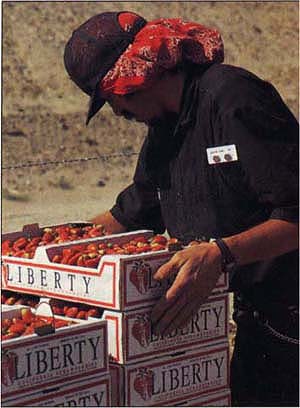All Issues
Progress report: High tech meets high touch
Publication Information
California Agriculture 48(2):5-5.
Published March 01, 1994
PDF | Citation | Permissions
Abstract
Individual production data electronic “touch” buttons worn in the field in the field may replace hand written hand-written tracking of production.
Full text
Most farm operations rely on copious handwritten records to track work hours and production of field workers, but electronic collection of such information appears to offer many advantages, according to UC Cooperative Extension labor management specialist Howard R. Rosenberg.
The Berkeley-based specialist is studying the implementation of a system that records worker presence and performance, builds a computer file from these data and formats it for payroll packages. Data can be collected in the field simply by making contact between an electronic sensor unit (“touch probe”) and a metallic disk (“touch button”).
This contact registers and time stamps an event in the sensor unit memory. An event can represent a unit for which workers are paid on a piece rate basis, the start or end of a work period, or both if there is a means to distinguish “production touches” from “time touches,” said Rosenberg.
Integral parts of the new data system are the touch-button badge, touch-probe, uploader, computer and operating software.
A touch button is a silicon memory chip housed in a stainless steel disk, about the size of a dime. The chip carries a unique machine-readable identification code. The steel enclosure protects it from impact, moisture, heat, dust, and other outdoor environmental stresses. Touch buttons are more durable and reliably read under field conditions than bar codes or magnetic stripes. Up to four buttons, which may correspond to different products paid at different rates, can be affixed to a hard plastic badge.
The probe is a steel-cased device the size of a small flashlight. It contains an internal time and date clock, a data storage medium (128K capacity), a sensor contact at one end, a sound and light emitting diode to signal contact and a 9-volt battery with lithium backup.
Any PC compatible computer can be used to receive and process uploaded data. Proprietary software prompts the user to pre-specify the employee associated with each button and the event it signifies.
The system was tested in the strawberry harvesting operation of Santa Maria-based Rancho Harvest, under the management of former Farm Advisor Kaimanu Francisco. After discussing this new method for counting their production, which was paid on a straight piece-rate basis, the 39 pickers pinned personalized touch-button badges to their sleeves and went to work.
When the pickers carried their packed cartons to the edge of the field, they got credited by turning sideways to make their badges accessible to the probe held by the checker. The traditional piece-rate card punching, in contrast, requires a series of motions by both the picker and the checker.
Touch-probe records were later uploaded to a portable computer in the field. Within minutes, summary reports of individual production were printed out and circulated. The pickers confirmed the figures were accurate.
Later that day the cooler reported receiving one more carton than the total 1,038 credited to individual pickers. This 0.1% discrepancy was the smallest of the year-old strawberry operation, where a 5–10 carton difference was typical.
Rosenberg observed several benefits of the system. It eliminates the supervisory burden of writing daily reports and the clerical chore of reading and keying their contents into the payroll system. Accuracy is enhanced, and the time-stamped documentation of production through the day aids in resolution of paycheck questions. Archival storage of electronic payroll data is compact and inexpensive.
Rosenberg noted these advantages are to be weighed against the cost of system equipment and software — conservatively estimated at less than $12,000 for an operation with 200 workers in six crews — and the lack of a tangible running record, like the punch card, for worker reference. While this innovation appears to have broad applicability, the experiences of early adopters should yield valuable lessons about how to use the system and introduce it to workers.
—Editor





